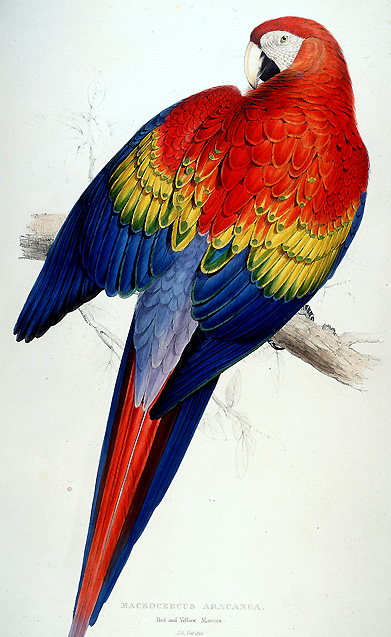

These birds are distributed
throughout tropical Mexico from Oaxaca on the west and southern
Tamaulipas on the east, south over Central and South America to
eastern Ecuador, eastern Peru, Bolivia, and Brazil south of the
Amazon in states of Amazonas and Pará (Peters 1937).
The Scarlet Macaw inhabits humid lowland forests, and rainforests which border rivers. The birds are seen in pairs or in flocks up to thirty that leave the roosting sites at sunrise, fly to the feeding grounds for the day (possibly at considerable distances from their roosts), and return as a group just before sunset.
Feathers from the Scarlet Macaw have been used similarly to those of the Blue and Gold Macaw. "The tail of the 'scarlet' is red; that of the 'blue and red' is dark red. The heads and breasts of both are red, - these feathers being very good as hackles. Along the back are light blue feathers; those from the blue and red being lighter in colour, and called 'powdered blue' feathers. Strands of the larger feathers that grow over the tail are frequently used in wings. On the back of the scarlet macaw are orange feathers; these are occasionally used whole in wings" (Hale 1892). V.C. (1950) mentions that feathers from the Scarlet Macaw are used as tags in grayling flies. Examples of flies that use the yellow greater wing coverts as whole-feather wings include Nelly Bly and May Queen, two dressings created by Major John P. Traherne (Schmookler 1993). Wheatley (1849) used the tail fibers from the Scarlet Macaw in mixed wings, while Pryce-Tannatt (1914) used Scarlet Macaw tail fibers as horns in full-dressed flies such as Dreadnought.
If you want to know more about the scarlet macaw and other birds related to our fly tying heritage, we suggest you order Rare and Unusual Fly Tying Materials: A Natural History.